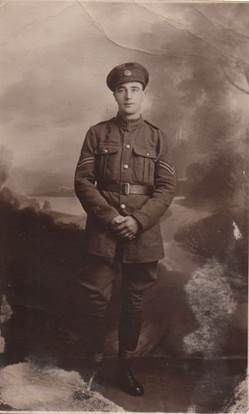
Figure 1. Corporal Robert Henry Langley, R.E.
(Image from the author’s collection)
135546
and WR/253574 Corporal
ROBERT HENRY LANGLEY
Royal
Engineers
By
Lieutenant Colonel Edward De
Santis, MSCE, P.E., MinstRE
(March 2023)

Figure
1. Corporal Robert Henry Langley, R.E.
(Image from the
author’s collection)
NOTE: This postcard photograph was taken by Sibley and Co., 9 Royston Parade, Beckenham Road, Penge, London. The following information is written in pencil on the reverse side of the postcard:
R.H. Langley
49, Wiverton Rd
Sydenham
London
S.E.
INTRODUCTION
The author was fortunate to locate Langley’s service papers on Ancestry.com. Unfortunately the papers were difficult to read as most entries had been written in pencil and were worn out to the point where they were barely legible. In addition, on some of the more important documents such as his Statement of Services, very few entries had been made. Attempts to locate family information on Ancestry.com were also disappointing. No family tree could be found for him and no civil documents could be located. The majority of the information contained in this narrative is based on what could be found in his service papers and from internet web sites and other published information dealing with the unit in which he served. Where no references are provided in the narrative, the reader should assume that the information came from Langley’s service papers. The sources of data will be cited in the Endnotes.
2. FAMILY INFORMATION AND EARLY LIFE
Family Information
Corporal Langley’s service papers indicate that his father was William James Langley, who in 1915 resided at 67 Palace Road in Upper Norwood, London, S.E. No additional information could be found about Robert Langley’s family from either his service papers or the internet.
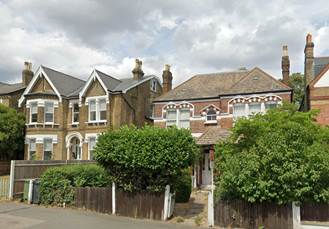
Figure
2. 67 Palace Road, Upper Norwood, London.
(Image
courtesy of Google Earth)
Early Life
Like the lack of information regarding his family, no information could be found about Robert’s early life other than that he lived at 49 Wiverton Road in Sydenham, London, S.E. and that he worked as a Bookstall Manager (Clerk) in 1915 when he decided to join the Army. Given his apparent age of 22 years and 6 months when he joined the Army in October of 1915, Robert would have been born about April of 1893.

Figure
3. 49 Wiverton Road, Sydenham, London.
(Image courtesy
of Google Earth)
2. PHYSICAL DESCRIPTION
The following is a brief description of Robert Langley at the time that he joined the Army in October of 1915.
Age: |
22 years and 6 months |
Height: |
5 feet 6¼ inches |
Girth fully expanded: |
35 inches |
Range of expansion: |
2 inches |
The description above is rather abbreviated and is not like the usual descriptions of new recruits which also contain color of eyes and hair, vaccination marks, distinctive marks on the body and sometimes weight.
3. RECRUITMENT, ENLISTMENT AND TRAINING
Recruitment
Although Robert Langley listed the Wiverton Road address when he enlisted, he appears to have been living at 36 Cliff Road in Fairfield, Buxton, Derbyshire when he first expressed interest in enlisting. What he was doing at this address at this time is not known. Somehow he contacted an officer of the Railway Troops Depot of the Royal Engineers at Longmoor Camp in Hampshire and expressed an interest in joining the Railway Troops. It is surprising that the officer that he contacted felt that Langley would be a valuable recruit since he had no experience with railways. Normally recruits for the Railway Troops had some experience with railways, with their construction or operation. At any rate on 12 October 1915 a Captain at the Railway Troops Depot wrote to Langley at the Buxton address to inform him that if he took the Captain’s letter to the nearest recruiting office they would enlist him and arrange for him to report to the Railway Troops Depot at Longmoor Camp, via Bordon on the London and South Western Railway.
Enlistment
Langley followed the Captain’s directions and presented himself to a recruiting office in Buxton and was taken in hand by one J.H. Green, perhaps a recruiter of the Sherwood Foresters regiment. He enlisted on 30 October 1915 in the Royal Engineers Railway Troops.
Langley’s enlistment was a Short Service Attestation for the duration of the Great War of 1914-1918. Upon his enlistment he was asked the usual questions put to a new recruit. Langley indicated that he was not married, had no prior naval or military service, was willing to be re-vaccinated and that he was enlisting for General Service. Following his enlistment he proceeded to Longmoor Camp.
On 6 November 1915 Robert Langley was examined at Longmoor and found fit for Active Service by Captain A. Phillips of the Royal Army Medical Corps. He was designated as a Sapper, Regimental Number 135546, and began his recruit training.
Training
Training was the principal activity at Longmoor. Emphasis was initially on construction rather than operating. The skilled engineers and technicians for this work came in many cases from the British-owned railways in South America. Little training was necessary for the rank and file and although some received a minimum of musketry trainings, others received little more military training than the rudiments of foot drill and units were either partially armed or, in some cases, sent to France unarmed altogether.[1]
There was very little collective or unit training before drafts were sent overseas. After his eight or so weeks of basic training and overseas leave, Langley was considered to be ready for active service. Following his recruit training Sapper Langley was posted to the 268th Railway Construction Company. Training of construction troops was formally placed under the Railway Construction Troops Depot, R.E.[2]
4. POSTINGS, ASSIGNMENTS AND CAMPAIGN SERVICE
General Information
The 268th Railway Construction Company consisted of 200 platelayers, 18 carpenters, 12 blacksmiths, 2 fitters, 2 engine drives, 1 clerk, 1 draughtsman, 2 cooks and an interpreter (French).[3] Langley’s service papers do not specifically indicate which of these trades he was assigned, however, since he had been a Clerk in civil life perhaps that is the trade he was assigned in the company.
Railway Construction Companies were used primarily to lay track, both standard and broad gauge. The companies also built railheads and yards. A typical railhead required over 6,000 tons of stone, which was in short supply. Labor and steam rollers, needed to compact the stone, were even scarcer. A railhead could not function without a large area for moving supplies, which often took longer to build than the railway infrastructure.
Railway construction and repair, while on the whole a comparatively safer occupation than being and infantry soldier at the front or even a Sapper in a field company of the Royal Engineers, was definitely hard work. The conditions were marginally better with more time spent in billets behind the line, but there were certainly many men in the companies who experienced arduous conditions within range of enemy artillery and on occasion close behind the front line. Lines of communication, such as railway lines, were a high priority target for deep artillery strikes and attacks by enemy aircraft. The 268th Railway Construction Company lost seven men on the Western Front. Details regarding these men will be presented later in the narrative.
The company normally would select routes which typically followed the easiest topography. This often led to very winding tracks because it took less labor and time. It was considered to be “good going” if a company could lay one mile of track a day in relatively flat ground where little grading was required. But even this topography required from 2,000 to 3,000 men, mostly from infantry pioneer battalions. One skilled worker from the company could supervise from 10 to 20 unskilled men. However, where grading and bridge construction were required, it would take one skilled man from the company to supervise 2 to 3 unskilled laborers.[4]
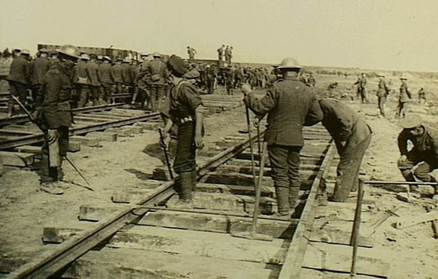
Figure
4. A Railway Construction Company at Work on the Western
Front.
(Image courtesy of Wikipedia)
Unfortunately no detailed information was uncovered to describe where the 268th Railway Construction Company operated in France and Belgium and Langley’s service papers do not provide this information.
France and Flanders (1916-1919)
Langley, then a Corporal, arrived in France on 19 December 1916 with the 268th Railway Construction Company. Without specific information as to the location of the company during the war, some idea of where it was and when, can be obtained from the locations of the casualties suffered by the company.[5]
202046 Sapper A.J. Darvill was the first company fatality. He was killed in the vicinity of Bailleul on 4 July 1917. Evidence that the company was working in the Bailleul area in July of 1917 is further indicated by the loss of two additional men from the company: 150842 Lance Corporal John Snelling (Westhof Farm)[6] on 23 July 1917 and 201916 Lance Corporal H. Amps (Trois Arbres) on 24 July 1917.
The company was working near Poperinge in October 1917 when 201978 Sapper J. Trevellyan (Dozinghem) was killed on 2 October and 275365 Sapper Alfred Pinder Adcock (Rouen) was killed on 12 October.
On 23 June 1918 WR/254405 Lance Corporal Arthur Thomas Shepherd was killed near Abbeville. The last company fatality was 275389 Sapper Horace Batson who died at home in the U.K. on 31 October 1918. Batson was from Wealdstone, Middlesex. He may have died of disease or as a result of wounds received during the war.
Corporal Langley returned home from France on 8 January 1919 suffering from DAH, a disorderly action of the heart, sometimes called “effort syndrome” or “soldier’s heart”. Often the result of stress or fatigue, it does not imply there was any organic disease. This ailment may have been the result of the strenuous physical activity that he experienced by working on railway construction. If it was, then he probably was not a Clerk in the 268th Railway Construction Company. He may in fact have been one of the 200 platelayers. He also had been promoted to the rank of Corporal early in the war, thus increasing his responsibilities and imposing added stress on him.
As a result of this ailment he was called before an Invaliding Board on 17 January 1919 to determine if his condition was the result of his military service. The board decided that it was and recommended his discharge. His service towards his engagement was reckoned to be 3 years and 100 days as shown in the table below.
Summary of Service
Station |
From: |
To: |
Years & Days |
Longmoor |
30 October 1915 |
18 December 1916 |
1 year and 50 days |
France and Belgium |
19 December 1916 |
7 January 1919 |
2 years and 20 days |
Woolwich |
8 January 1919 |
6 February 1919 |
30 days |
Total Service: |
3 years & 100 days |
||
5. DISCHARGE
WR/253274 Corporal Robert Henry Langley was discharged on 6 February 1919 as he was no longer physically fit for war service.[7] The Invaliding Board determined that his degree of disability from DAH amounted to 30 percent.
___________________________________________________________
The following sections are presented in tabular form to summarize Corporal Langley’s promotions, appointments, military training and qualifications and the medals that he was awarded during his time in the Army. They are provided to give the reader easy access to these aspects of his military career.
__________________________________________________________________________
Date of Promotion
|
|
30 October 1915 |
Sapper, upon enlistment. |
16 May 1916 |
Appointed Lance Corporal. |
6 June 1916 |
Promoted 2nd Corporal. |
2 September 1916 |
Promoted Corporal. |
Disciplinary Actions
There was no record of any disciplinary actions against Langley in his service record.
Good Conduct Badges
There was no record of him receiving any Good Conduct Badges in his service papers, although undoubtedly he must have been eligible for one badge after completing two years of service. Additionally, he had risen from the rank of Sapper to the rank of Corporal in less than one year, thus indicating that his conduct and performance of duty must have been exemplary.
8. MEDALS, AWARDS AND DECORATIONS
For his service during the war Corporal Langley was awarded the British War Medal and Victory Medal as shown in his Medal Index Card in Figure 4 below. The card also shows that he was awarded the Silver War Badge as a result of the illness attributed to his military service.
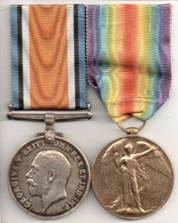
Figure
5. British War Medal and Victory Medal.
(Image from
the author’s collection)
NOTE: These medals are not those awarded to Langley. The whereabouts of his medals are not known. The image above is provided to indicate what his medals would look like.
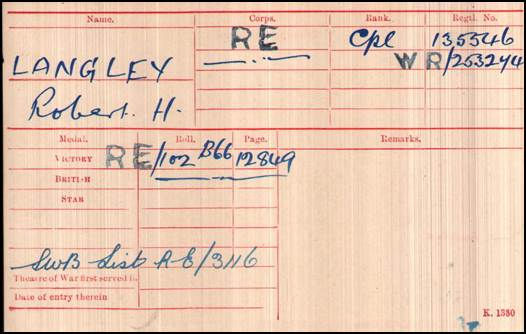
Figure
6. The Medal Index Card of Corporal Robert H. Langley,
R.E.
(Image courtesy of Ancestry.com)
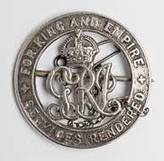
Figure
7. The Silver War Badge.
(Image from the author’s
collection)
See NOTE under Figure 5 above.
9. EDUCATION AND QUALIFICATIONS
Other than the training he received at Longmoor Camp after his enlistment, there is no information available about his education or qualifications.
10. MEDICAL INFORMATION
Based on the information contained in his service papers, Langley was healthy and fit for military service in 1915 when he enlisted in the Army. The rigorous work required of him as a member of a railway construction company may have been the cause of his being affected by disorderly action of the heart (DAH). The clinical name for DAH is Da Costa's syndrome (also known as "soldier's heart", cardiac neurosis, chronic asthenia, effort syndrome, functional cardiovascular disease, neurocirculatory asthenia, primary neurasthenia, subacute asthenia and irritable heart). It is a psychiatric syndrome which presents a set of symptoms similar to those of heart disease. These include fatigue upon exertion, shortness of breath, palpitations, sweating, and chest pain.[8]
No information available.
12. POST SERVICE LIFE
No information available
13. EPILOGUE
The following information is from The Long, Long Trail internet web site (Railway Construction Companies of the Royal Engineers). It provides a description of the importance of these companies to the war effort and a tribute to their service.
The contribution to the war effort, especially on the Western Front, of the designated Railway Construction Companies of the Royal Engineers is largely overlooked and/or not researched in most accounts of the conflict. Given the fact that the earliest troop movements gave rise to the phrase “war by timetable” and that the railway was the primary means of movement of men, munitions and supplies, the important if unglamorous role of this military function cannot be underestimated.
As the various campaigns and battles unfolded, RE Railway Companies were engaged all over the British sector, joined by Dominion RE Railway Companies. Close examination of the period maps bear testimony to miles of what was to be temporary track that criss-crossed the area. Howitzer Spurs, Ambulance Train Sidings, Tank Enablements and bridges were all constructed, in addition to the constant maintenance and line doubling. Work in progress was always a potential target for enemy artillery and also there were the attentions of the German Air Force to contend with. Zeneghem Yard, for instance, was a natural target and sappers from RE Railway Companies are recorded as having to help extinguish serious fires resulting from air raids.
A primary objective was always to take standard gauge railways as close to the front as possible, to lessen the demands on light railway systems, horsed transport and manpower. For the sappers, work could mean toiling around the clock, especially where lines had been cut by shellfire. Inevitably there were casualties; analysis of the records shows that 173 men from Railway Companies lost their lives. Most of the men in the RE Railway Companies had enlisted for the duration of the war and were naturally keen to return home as soon as possible. However, there was still much line repair work to be done in order to restore the lines of communication now extending deeper into the areas formerly held by the Germans. The Railway Companies gradually began to be demobilised and by August 1919 the last Company had laid its last sleeper.
REFERENCES:
Books
HIGGINS, J. Great War Railwaymen: Britain’s Railway Company Workers at War, 1914-1918. Uniform Press, London, 2014.
RONALD, D.W. & CARTER, R.J. The Longmoor Military Railway. David & Charles, Newton Abbot, 1974.
Internet Web Sites
Commonwealth War Graves Commission.
Railway Construction Companies of the Royal Engineers: The Long, Long Trail.
VAH and DAH: The Long, Long Trail.
Da Costa’s Syndrome.
Military Documents
WW1 Pension Record Cards and Ledgers.
Medal Index Card.
Silver War Badge, R.E. List 3116.
Service Papers
a. Short Service Attestation (Duplicate).
b. Short Service Attestation (Original).
c. Letter to R.H. Langley from O.C. Railway Troops Depot, R.E., dated 12 October 1915, re: Enlistment.
d. Health Certificate of Recruit, Royal Engineers Railway and Canal Troops.
e. Report on Enlistment.
f. Identity Certificate of Recruit, Royal Engineers Railway and Canal Troops.
g. List of Transfer Document.
h. Squadron, Troop, Battery and Company Conduct Sheet.
i. Statement of Service (Army Form B. 200).
j. Notification of an Invaliding Board.
k. Disability Form B. 105-53.
l. Approval of Discharge.
m. Post Card acknowledging receipt of the British War Medal and Victory Medal (Army Form B. 5112).
n. Ministry of Pensions Memo dated 6 March 1919 to Officer Commanding R.E.T.D.
ENDNOTES:
[1] RONALD & CARTER, p. 51.
[2] Ibid.
[3] HIGGINS, p. 114.
[4] Ibid.
[5] Commonwealth War Graves Commission.
[6] The locations in parentheses indicate the place of burial of each man.
[7] At some point during his service in France his Regimental Number was changed from 135546 to WR/253574.
[8] Wikipedia.